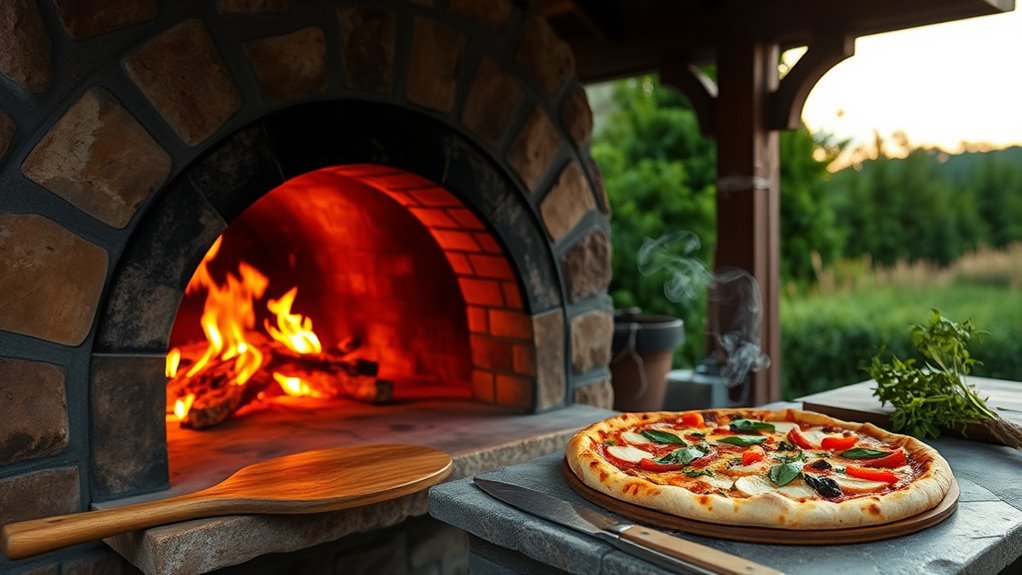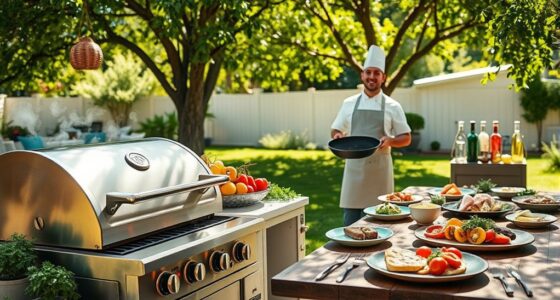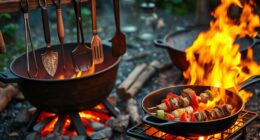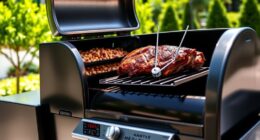Mastering wood-fired cooking transforms your dishes with rich, smoky flavors and authentic appeal that modern appliances can’t match. By selecting the right hardwoods, properly seasoning your wood, and managing your fire carefully, you’ll control heat and infuse your food with signature aromas. Developing these skills allows you to cook pizza and beyond with confidence, creating deep flavors and a unique atmosphere. Keep exploring, and you’ll discover how to elevate your outdoor cooking skills to a professional level.
Key Takeaways
- Choose properly seasoned hardwoods like oak or hickory for consistent heat and rich smoky flavor.
- Build a clean, hot fire using small kindling and gradually add larger logs for optimal temperature control.
- Manage fire airflow to maintain steady heat and prevent excess soot or resin buildup.
- Adjust fuel types and quantities based on desired flavor profile and cooking duration.
- Develop skills in fire management to improve flavor infusion and extend oven lifespan.

Wood-fired cooking offers a unique flavor and authentic experience that modern appliances can’t match. When you fire up a wood oven, you’re not just heating food—you’re infusing it with a rich, smoky aroma that elevates every bite. The key to achieving this distinctive taste lies in understanding how different fuel types influence the wood flavor and the overall cooking process. Whether you opt for seasoned hardwoods like oak, hickory, or fruitwoods, each offers a different profile that impacts the taste of your dishes. Hardwoods tend to burn longer and produce a steadier heat, giving your food a consistent, deep smoky flavor. Fruitwoods, such as apple or cherry, add a sweeter, milder aroma that pairs beautifully with meats and baked goods. Softwoods like pine or cedar, however, should generally be avoided because they burn quickly and can release resin that taints the flavor and can even be harmful.
As you select your fuel types, keep in mind that the quality and dryness of the wood are vital. Properly seasoned wood, with a moisture content below 20%, burns cleaner and hotter, which helps you control the temperature more precisely and enhances the wood flavor without introducing unwanted bitterness or soot. When you build your fire, start with small kindling and gradually add larger pieces to establish a hot, clean-burning fire. This approach guarantees you get the ideal temperature for your cooking, whether you’re roasting a pizza or slow-smoking ribs. The type of fuel you choose will influence your cooking experience, affecting how quickly the fire reaches the desired heat and how evenly it sustains that heat.
Using the right fuel types also extends your oven’s lifespan. Hardwoods produce less creosote buildup, reducing maintenance and keeping your oven in top shape. Plus, a good fire with well-chosen wood creates an inviting atmosphere, making the entire cooking process more enjoyable. When you master the art of selecting and managing your fuel types, you’ll notice a significant difference in your results. The wood flavor becomes more pronounced, and your dishes develop that signature smoky essence that only wood-fired cooking can deliver. Over time, you’ll learn how different woods influence your food and adjust your techniques accordingly, revealing the full potential of your wood-fired oven. This knowledge transforms cooking from a simple task into a craft, allowing you to create culinary experiences that capture the essence of traditional, authentic flavors.
A crucial aspect of wood-fired cooking is understanding how seasoned hardwoods burn more efficiently and produce a cleaner, more consistent heat, which enhances the overall flavor of your dishes.
Frequently Asked Questions
How Do I Properly Maintain a Wood-Fired Pizza Oven?
To properly maintain your wood-fired pizza oven, you should establish regular cleaning routines by removing ashes and debris after each use. Check insulation for any damage and replace it if needed, ensuring efficient heat retention. Also, inspect the chimney for blockages and clean it periodically. These steps keep your oven in top shape, prolong its lifespan, and improve cooking results, making every pizza perfect.
What Types of Wood Are Best for Different Dishes?
Did you know that choosing the right types of wood can enhance your dishes considerably? For example, fruitwoods like cherry and apple impart sweet, mild flavors perfect for poultry and fish, while hardwoods like oak and hickory add smoky intensity ideal for beef and ribs. Understanding flavor profiles helps you select the best wood for each dish, elevating your wood-fired cooking experience and ensuring delicious, well-balanced results every time.
How Do I Control the Temperature in a Wood-Fired Oven?
To control the temperature in your wood-fired oven, start by placing a thermometer at the oven’s center to monitor heat levels accurately. Regulate airflow by adjusting the vents or dampers; opening them increases oxygen, raising the temperature, while closing them lowers it. Keep an eye on the thermometer and tweak the airflow as needed to maintain your desired cooking temperature, ensuring perfect results every time.
Can I Cook Desserts in a Wood-Fired Oven?
Yes, you can definitely cook desserts in a wood-fired oven. Use dessert techniques like indirect heat and adjust your oven’s temperature to avoid burning delicate treats. Try sweet recipes such as baked apples, fruit crisps, or s’mores. Keep an eye on your desserts as they cook, and use a thermometer if needed. With patience and experimentation, you’ll master wood-fired desserts that add a smoky, rich flavor to your sweet creations.
What Safety Precautions Should I Follow When Using a Wood-Fired Oven?
Imagine you’re baking a pizza in your wood-fired oven, and suddenly flames flare up. You should always keep a fire extinguisher nearby for fire extinguisher safety, and avoid opening the oven door abruptly to prevent smoke and heat injury. Always wear heat-resistant gloves, and make sure kids stay clear. By following these precautions, you keep your cooking safe and enjoyable.
Conclusion
Now that you’ve learned the ins and outs of wood-fired cooking, you’re all set to impress with mouthwatering pizzas and more. Just remember, practice makes perfect, so don’t be afraid to get your hands dirty. With patience and a little fire, you’ll turn your backyard into a culinary haven. So, go ahead—fire up that oven and show everyone that Rome wasn’t built in a day, but your skills can be!









